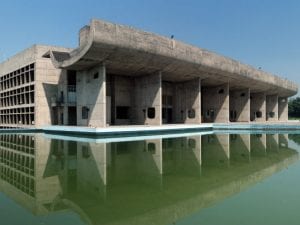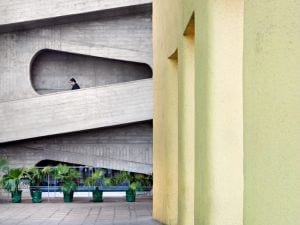Le Corbusier and Léger. Polychromatic conversations exists in dialogue with Centre Pompidou-Metz‘s retrospective on Fernand Léger. Staged at Cité Radieuse in Briey, this off-site event is an invitation for audiences to rediscover an iconic Le Corbusier building, as well as reflecting on the duo’s long friendship marked by a shared celebration of colour. Conceived in partnership with La Première Rue and le Val de Briey, the exhibition has benefited from support from Le Corbusier Foundation. Packed with a rich collection of archival material – reviews, films, photographs, correspondence and more – the exhibition sheds new light on a number of their projects.
Located just 40 minutes from Metz, Le Corbusier and Léger offers a site-specific stimulus for audiences to consider in addition to the more conventional presentation of Léger’s work at the gallery. After having discovered the region on the front at Verdun during World War One, it was in the Briey basin in 1940 that Léger imagined the setting for an aviation centre. Some years later, Le Corbusier, who had a passion for what he called “flying machines,” explored the Lorraine region with an experiment in polychromy as part of the construction of the factory in Saint Dié, before working on his housing estate in Briey in the 1950s.
Le Corbusier and Léger first met at the café La Rotonde in Montparnasse,1920, a year in which the review L’Esprit Nouveau, initiated by the architect and painter Amédée Ozenfant, stated on its cover: “architecture, painting, music, pure and applied sciences, experimental aesthetics, engineering aesthetics, urbanism, philosophy, economic sociology, moral and political sciences, modern life, theatre, performing arts, sports news.” These industrious words impacted on both the artist and architect’s work, and, in 1925, Le Corbusier invited Léger to hang a canvas in his pavilion of the Esprit Nouveau on the occasion of the International Exhibition of Decorative Arts. This was followed by Léger contribution to Le Corbusier’s Temps nouveaux Pavilion with the production of a monumental photomontage in 1937.
While they only collaborated a few times, their exchanges influenced the role they attached to polychromy in their respective projects. Throughout his career Léger was convinced by the interdisciplinary nature of the arts, and he worked in favour of an understanding between the wall, the architect and the painter. “How can we create a feeling of space, a pushing back of limits? Simply with colour…it creates a new space.” Likewise, Le Corbusier stated in his Almanac of Modern Architecture that “completely white, the house would be a pot of cream.”
Le Corbusier and Léger, until 24 September, Cité radieuse Le Corbusier, 131 Résidence Le Corbusier, 1er étage, 54150 Briey-en-Forêt.
Find out more: www.centrepompidou-metz.fr/en/le-corbusier-and-l-ger-polychromatic-conversations.
Credits
1. Cité radieuse Le Corbusier.




